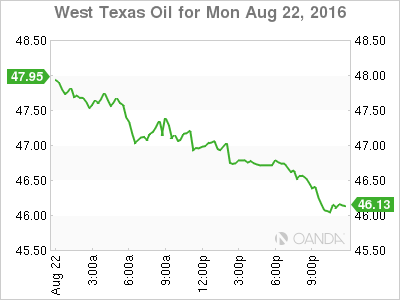The Canadian dollar depreciated versus its U.S. counterpart in the first trading session of the week after the price of energy fell following reports of higher exports and higher number of rigs. The Canadian dollar had touched post-Brexit highs last week on the back of USD weakness as comments from the U.S. Federal Reserve have been mixed about monetary policy. The market is waiting for Friday’s speech by Fed Chair Janet Yellen looking for insights into the timing of the next interest rate hike. With San Francisco President John Williams putting on the table a possible change to the central bank’s inflation target the possibility of the Fed not changing its benchmark rate for 2016 gained traction. Comments from other Fed members offset some of the dovish view but the fact remains that for all the hawkish Fed rhetoric for some members, its actions and internal debates are reducing the possibility of a rate hike in September.
Loonie Lower Despite Canadian Wholesale Rise
This week will be light for economic indicators in Canada. The release of the Canadian wholesale sales showed a rise of 0.7 percent. The positive news was taken into context as wholesale sales account for about 5 percent of GDP. The fall in the price of energy soon took the price of the CAD to weekly lows as reports showed a rise in production output as well as a higher rig count in the U.S. The reality of a supply glut drove prices lower and it will take more than producer promises of an oil output freeze to again challenge the $50 level. The Organization of the Petroleum Exporting Countries (OPEC) is anticipated to discuss the output freeze in the upcoming meeting in late September with non-OPEC members interested in joining, but for the time being not committing to anything.
USD Bounced Back Ahead of Jackson Hole

The USD/CAD lost 0.6 percent in the last 24 hours. The pair is trading at 1.2946 as the heavy correlation with energy prices took its toll on the loonie. The USD bounced back after last week’s losses triggered by Fed member comments and lack of meaningful data. The Canadian dollar will find no support from economic releases as the week will be focused on the U.S. Federal Reserve and Chair Yellen’s speech on Friday at the Jackson Hole summit. The market is starting to doubt the Fed will make even a single hike to the benchmark rate in 2016 as standing pat while other central banks are forced to go deeper into negative rates is seen as an alternative to preserve the interest rate divergence. The gap is not expected to grow at a fast rate by analysts or economists as both the easing and tightening camps are taking cautious steps.
CAD Oil Correlation Drags Currency Lower

West Texas Oil lost 3.143 in the last 24 hours. The price of energy is trading at $46.78 as producers are keeping the tabs open with no signs of pickup in demand. The Organization of the Petroleum Exporting Countries (OPEC) and other producers are open to a oil output freeze, but so far it has only been rhetoric and even if it comes to pass it would mean freezing production at record high levels.
The Canadian dollar will impacted by market expectations on U.S. rates and the price of energy. Canadian fundamentals have taken a backseat as signals have been mixed with some positives but overall a negative growth outcome expected in the third quarter. The USD/CAD is again threatening the 1.30 resistance level as the greenback regains strength based on the speculation of central bank rates going forward.
Market events to watch this week:
Tuesday, August 23
12:00am JPY BOJ Gov Kuroda Speaks
Wednesday, August 24
10:30am USD Crude Oil Inventories
Thursday, August 25
4:00am EUR German Ifo Business Climate
8:30am USD Core Durable Goods Orders m/m
8:30am USD Unemployment Claims
Friday, August 26
4:30am GBP Second Estimate GDP q/q
8:30am USD Prelim GDP q/q
ALL DAY Jackson Hole Economic Policy Symposium
